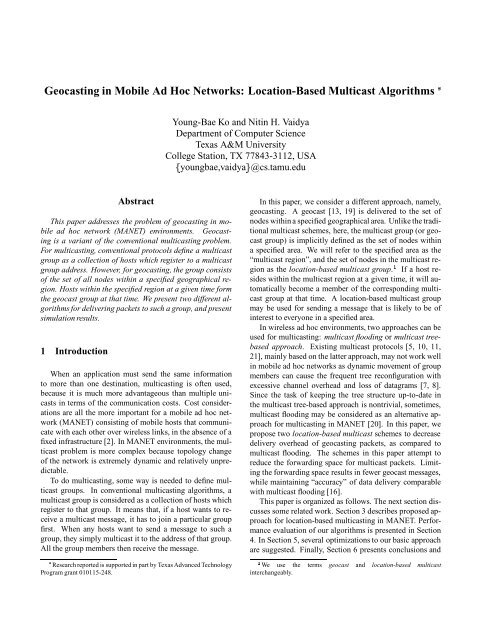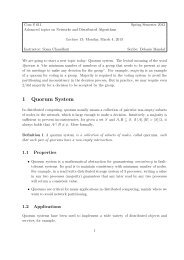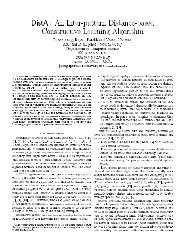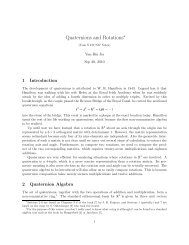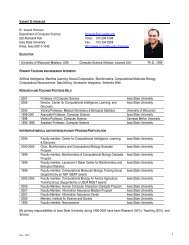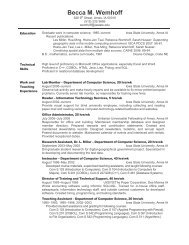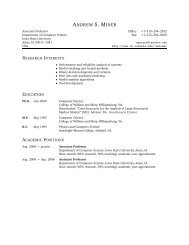Geocasting in Mobile Ad Hoc Networks: Location-Based ... - CiteSeerX
Geocasting in Mobile Ad Hoc Networks: Location-Based ... - CiteSeerX
Geocasting in Mobile Ad Hoc Networks: Location-Based ... - CiteSeerX
Create successful ePaper yourself
Turn your PDF publications into a flip-book with our unique Google optimized e-Paper software.
<strong>Geocast<strong>in</strong>g</strong> <strong>in</strong> <strong>Mobile</strong> <strong>Ad</strong> <strong>Hoc</strong> <strong>Networks</strong>: <strong>Location</strong>-<strong>Based</strong> Multicast Algorithms<br />
Abstract<br />
This paper addresses the problem of geocast<strong>in</strong>g <strong>in</strong> mobile<br />
ad hoc network (MANET) environments. <strong>Geocast<strong>in</strong>g</strong><br />
is a variant of the conventional multicast<strong>in</strong>g problem.<br />
For multicast<strong>in</strong>g, conventional protocols def<strong>in</strong>e a multicast<br />
group as a collection of hosts which register to a multicast<br />
group address. However, for geocast<strong>in</strong>g, the group consists<br />
of the set of all nodes with<strong>in</strong> a specified geographical region.<br />
Hosts with<strong>in</strong> the specified region at a given time form<br />
the geocast group at that time. We present two different algorithms<br />
for deliver<strong>in</strong>g packets to such a group, and present<br />
simulation results.<br />
1 Introduction<br />
When an application must send the same <strong>in</strong>formation<br />
to more than one dest<strong>in</strong>ation, multicast<strong>in</strong>g is often used,<br />
because it is much more advantageous than multiple unicasts<br />
<strong>in</strong> terms of the communication costs. Cost considerations<br />
are all the more important for a mobile ad hoc network<br />
(MANET) consist<strong>in</strong>g of mobile hosts that communicate<br />
with each other over wireless l<strong>in</strong>ks, <strong>in</strong> the absence of a<br />
fixed <strong>in</strong>frastructure [2]. In MANET environments, the multicast<br />
problem is more complex because topology change<br />
of the network is extremely dynamic and relatively unpredictable.<br />
To do multicast<strong>in</strong>g, some way is needed to def<strong>in</strong>e multicast<br />
groups. In conventional multicast<strong>in</strong>g algorithms, a<br />
multicast group is considered as a collection of hosts which<br />
register to that group. It means that, if a host wants to receive<br />
a multicast message, it has to jo<strong>in</strong> a particular group<br />
first. When any hosts want to send a message to such a<br />
group, they simply multicast it to the address of that group.<br />
All the group members then receive the message.<br />
Research reported is supported <strong>in</strong> part by Texas <strong>Ad</strong>vanced Technology<br />
Program grant 010115-248.<br />
Young-Bae Ko and Nit<strong>in</strong> H. Vaidya<br />
Department of Computer Science<br />
Texas A&M University<br />
College Station, TX 77843-3112, USA<br />
fyoungbae,vaidyag@cs.tamu.edu<br />
In this paper, we consider a different approach, namely,<br />
geocast<strong>in</strong>g. A geocast [13, 19] is delivered to the set of<br />
nodes with<strong>in</strong> a specified geographical area. Unlike the traditional<br />
multicast schemes, here, the multicast group (or geocast<br />
group) is implicitly def<strong>in</strong>ed as the set of nodes with<strong>in</strong><br />
a specified area. We will refer to the specified area as the<br />
“multicast region”, and the set of nodes <strong>in</strong> the multicast region<br />
as the location-based multicast group. 1 If a host resides<br />
with<strong>in</strong> the multicast region at a given time, it will automatically<br />
become a member of the correspond<strong>in</strong>g multicast<br />
group at that time. A location-based multicast group<br />
may be used for send<strong>in</strong>g a message that is likely to be of<br />
<strong>in</strong>terest to everyone <strong>in</strong> a specified area.<br />
In wireless ad hoc environments, two approaches can be<br />
used for multicast<strong>in</strong>g: multicast flood<strong>in</strong>g or multicast treebased<br />
approach. Exist<strong>in</strong>g multicast protocols [5, 10, 11,<br />
21], ma<strong>in</strong>ly based on the latter approach, may not work well<br />
<strong>in</strong> mobile ad hoc networks as dynamic movement of group<br />
members can cause the frequent tree reconfiguration with<br />
excessive channel overhead and loss of datagrams [7, 8].<br />
S<strong>in</strong>ce the task of keep<strong>in</strong>g the tree structure up-to-date <strong>in</strong><br />
the multicast tree-based approach is nontrivial, sometimes,<br />
multicast flood<strong>in</strong>g may be considered as an alternative approach<br />
for multicast<strong>in</strong>g <strong>in</strong> MANET [20]. In this paper, we<br />
propose two location-based multicast schemes to decrease<br />
delivery overhead of geocast<strong>in</strong>g packets, as compared to<br />
multicast flood<strong>in</strong>g. The schemes <strong>in</strong> this paper attempt to<br />
reduce the forward<strong>in</strong>g space for multicast packets. Limit<strong>in</strong>g<br />
the forward<strong>in</strong>g space results <strong>in</strong> fewer geocast messages,<br />
while ma<strong>in</strong>ta<strong>in</strong><strong>in</strong>g “accuracy” of data delivery comparable<br />
with multicast flood<strong>in</strong>g [16].<br />
This paper is organized as follows. The next section discusses<br />
some related work. Section 3 describes proposed approach<br />
for location-based multicast<strong>in</strong>g <strong>in</strong> MANET. Performance<br />
evaluation of our algorithms is presented <strong>in</strong> Section<br />
4. In Section 5, several optimizations to our basic approach<br />
are suggested. F<strong>in</strong>ally, Section 6 presents conclusions and<br />
1We use the terms geocast and location-based multicast<br />
<strong>in</strong>terchangeably.
future work.<br />
2 Related Work<br />
Multicast<strong>in</strong>g <strong>in</strong> mobile ad hoc networks is a relatively<br />
unexplored research area, when compared to the area of unicast<br />
rout<strong>in</strong>g for MANET [22]. However, recently, several<br />
protocols for multicast<strong>in</strong>g <strong>in</strong> MANET environments have<br />
been proposed [8, 7, 14, 23]. Reference [8] adapts fixed<br />
network multicast approaches (PIM Sparce Mode) to the<br />
MANET and proposes the Shared-Tree Wireless Network<br />
Multicast (ST-WIM) protocol. <strong>Ad</strong>hoc Multicast Rout<strong>in</strong>g<br />
(AMRoute) protocol [7] and Lightweight <strong>Ad</strong>aptive Multicast<br />
(LAM) protocol [14] are some other protocols for<br />
MANET multicast rout<strong>in</strong>g. Both algorithms may be categorized<br />
as tree-based approaches, as a group-shared forward<strong>in</strong>g<br />
tree is created and ma<strong>in</strong>ta<strong>in</strong>ed <strong>in</strong> LAM and usermulticast<br />
trees are exploited <strong>in</strong> AMRoute with dynamic<br />
cores. In the <strong>Ad</strong> <strong>Hoc</strong> Multicast Rout<strong>in</strong>g protocol utiliz<strong>in</strong>g<br />
Increas<strong>in</strong>g id-numbers (AMRIS)[23], a shared delivery tree<br />
rooted at a special node is constructed and ma<strong>in</strong>ta<strong>in</strong>ed.<br />
The closest work to ours is GeoCast by Navas and<br />
Imiel<strong>in</strong>ski [13, 19]. In their scheme also, multicast group<br />
members are (implicitly) def<strong>in</strong>ed as all nodes with<strong>in</strong> a<br />
certa<strong>in</strong> region. To support location-dependent services<br />
such as geographically-targeted advertis<strong>in</strong>g, they suggested<br />
three methods: geo-rout<strong>in</strong>g with location aware routers,<br />
geo-multicast<strong>in</strong>g modify<strong>in</strong>g IP multicast, and an application<br />
layer solution us<strong>in</strong>g extended Doma<strong>in</strong> Name Service<br />
(DNS). This paper considers geocast<strong>in</strong>g <strong>in</strong> mobile ad hoc<br />
networks.<br />
The algorithms proposed <strong>in</strong> this paper are based upon<br />
a multicast flood<strong>in</strong>g approach and the basic idea of the algorithms<br />
is derived from protocols we previously proposed<br />
for rout<strong>in</strong>g <strong>in</strong> mobile ad hoc networks [15]. In [15], we<br />
presented an approach to utilize location <strong>in</strong>formation to improve<br />
performance of rout<strong>in</strong>g protocols <strong>in</strong> MANET. To decrease<br />
overhead of route discovery by limit<strong>in</strong>g the search<br />
space for a desired route, the schemes use physical location<br />
<strong>in</strong>formation for mobile hosts, which may be obta<strong>in</strong>ed us<strong>in</strong>g<br />
the global position<strong>in</strong>g system (GPS) [1]. Similar ideas have<br />
been applied to develop selective pag<strong>in</strong>g for cellular PCS<br />
(Personal Communication Service) networks [3]. In selective<br />
pag<strong>in</strong>g, the system pages a selected subset of cells close<br />
to the last reported location of a mobile host. This allows<br />
the location track<strong>in</strong>g cost to be decreased.<br />
Metricom is another example of packet radio systems us<strong>in</strong>g<br />
location <strong>in</strong>formation for the rout<strong>in</strong>g purpose [18]. In<br />
the Metricom network <strong>in</strong>frastructure, location of fixed base<br />
stations is determ<strong>in</strong>ed us<strong>in</strong>g a GPS receiver at the time of<br />
<strong>in</strong>stallation. Metricom uses a geographically based rout<strong>in</strong>g<br />
scheme to deliver packets between base stations. A packet<br />
is forwarded one hop closer to its f<strong>in</strong>al dest<strong>in</strong>ation by com-<br />
2<br />
par<strong>in</strong>g the location of packet’s dest<strong>in</strong>ation with the location<br />
of the node currently hold<strong>in</strong>g the packet. Recently, another<br />
way of us<strong>in</strong>g location <strong>in</strong>formation for rout<strong>in</strong>g protocol<br />
has been proposed <strong>in</strong> [6]. Their protocol, named DREAM,<br />
ma<strong>in</strong>ta<strong>in</strong>s location <strong>in</strong>formation of each node <strong>in</strong> rout<strong>in</strong>g tables<br />
and sends data messages <strong>in</strong> a direction computed based<br />
on these rout<strong>in</strong>g (location) tables. To ma<strong>in</strong>ta<strong>in</strong> the location<br />
table accurately, each node periodically broadcasts a control<br />
packet conta<strong>in</strong><strong>in</strong>g its own coord<strong>in</strong>ates, with the frequency of<br />
dissem<strong>in</strong>ation computed as a function of the node’s mobility<br />
and the distance separat<strong>in</strong>g two nodes (called the distance<br />
effect).<br />
3 <strong>Location</strong>-<strong>Based</strong> Multicast Protocols<br />
Two approaches may be used to implement locationbased<br />
multicast:<br />
Ma<strong>in</strong>ta<strong>in</strong> a multicast tree, such that all nodes with<strong>in</strong><br />
the multicast region at any time belong to the multicast<br />
tree. The tree would need to be updated whenever<br />
nodes enter or leave the multicast region.<br />
Do not ma<strong>in</strong>ta<strong>in</strong> a multicast tree. In this case, the multicast<br />
may be performed us<strong>in</strong>g some sort of “flood<strong>in</strong>g”<br />
scheme. As elaborated below, this is the approach<br />
taken <strong>in</strong> this paper.<br />
3.1 Multicast Flood<strong>in</strong>g<br />
Flood<strong>in</strong>g is probably the simplest multicast rout<strong>in</strong>g algorithm<br />
[12]. The flood<strong>in</strong>g algorithm can be used to deliver<br />
packets to nodes with<strong>in</strong> a location-based multicast group.<br />
The multicast flood<strong>in</strong>g algorithm can be implemented as<br />
follows: Assume that a node S needs to send a packet to<br />
a specific multicast region, a circle <strong>in</strong> Figure 1. Node S<br />
broadcasts the multicast packet to all its neighbors 2 – hereafter,<br />
node S will be referred to as the sender and nodes D,<br />
F, and G as the multicast group members (note that <strong>in</strong> Figure<br />
1 all nodes present <strong>in</strong> the specified multicast region are,<br />
by def<strong>in</strong>ition, multicast group members). A node, say B or<br />
C, on receiv<strong>in</strong>g the packet, compares the specified region’s<br />
coord<strong>in</strong>ates with its own location. (We assume that all hosts<br />
are able to determ<strong>in</strong>e their own location us<strong>in</strong>g GPS.) If the<br />
location of B is with<strong>in</strong> the specified multicast region, node<br />
B will accept the packet. Node B will also broadcast the<br />
packet to its neighbors, if it has not received the packet previously<br />
(repeated reception of a packet is detected us<strong>in</strong>g sequence<br />
numbers). If node B is located outside the multicast<br />
region and the packet was not received previously, it just<br />
broadcasts the packet to its neighbors. In Figure 1, when<br />
2 Two nodes are said to be neighbors if they can communicate with each<br />
other over a wireless l<strong>in</strong>k.
node X receives the packet from B, it forwards the packet<br />
to its neighbors. However, when node X receives the same<br />
packet from C, node X simply discards the packet. Similarly,<br />
when node D receives a multicast packet from X,<br />
it forwards the packet to its neighbors after accept<strong>in</strong>g the<br />
packet.<br />
S<br />
A<br />
X<br />
D<br />
B<br />
G<br />
E<br />
multicast data packet<br />
Figure 1. Illustration of multicast flood<strong>in</strong>g<br />
Us<strong>in</strong>g the above flood<strong>in</strong>g algorithm, provided that the<br />
<strong>in</strong>tended multicast group members are reachable from the<br />
sender, the members should eventually receive a multicast<br />
message. It is possible that some group members will not<br />
receive the packet (for <strong>in</strong>stance, when they are unreachable<br />
from the sender, or multicast messages are lost due to transmission<br />
errors).<br />
This algorithm would be very simple and robust but<br />
would not be very efficient. When us<strong>in</strong>g the above algorithm,<br />
observe that <strong>in</strong> the absence of transmission errors, the<br />
multicast packet would reach all nodes reachable from the<br />
sender S, not just the nodes <strong>in</strong> the multicast region. Us<strong>in</strong>g<br />
location <strong>in</strong>formation of the source and the specified multicast<br />
region, we attempt to reduce the number of nodes,<br />
outside the multicast region, to whom a multicast packet is<br />
propagated.<br />
3.2 Prelim<strong>in</strong>aries<br />
<strong>Location</strong> Information<br />
The proposed approach is termed location-based multicast,<br />
as it makes use of location-based multicast groups and utilizes<br />
location <strong>in</strong>formation to reduce multicast delivery overhead.<br />
<strong>Location</strong> <strong>in</strong>formation used <strong>in</strong> our protocol may be<br />
provided by the global position<strong>in</strong>g system (GPS) [1]. With<br />
the availability of GPS, it is possible for a mobile host to<br />
know its physical location 3 . (In this paper, we assume<br />
3 Current GPS provides accurate three-dimensional position (latitude,<br />
longitude, and altitude), velocity, and precise time traceable to Coord<strong>in</strong>ated<br />
Universal Time(UTC) [1]<br />
C<br />
F<br />
3<br />
that the mobile nodes are mov<strong>in</strong>g <strong>in</strong> a two-dimensional<br />
plane.) In reality, position <strong>in</strong>formation provided by GPS<br />
<strong>in</strong>cludes some amount of error, which is the difference between<br />
GPS-calculated coord<strong>in</strong>ates and the real coord<strong>in</strong>ates.<br />
For <strong>in</strong>stance, NAVSTAR Global Position<strong>in</strong>g System has positional<br />
accuracy of about 50-100 meters and Differential<br />
GPS offers accuracies of a few meters [1]. In our discussion,<br />
we assume that each host knows its current location<br />
precisely (i.e., no error). However, our algorithms can be<br />
easily extended to take location error <strong>in</strong>to account, similar<br />
to the rout<strong>in</strong>g algorithms <strong>in</strong> [15].<br />
Multicast Region and Forward<strong>in</strong>g Zone<br />
Multicast Region: Consider a node S that needs to multicast<br />
a message to all nodes that are currently located with<strong>in</strong><br />
a certa<strong>in</strong> geographical region. We call this specific area as<br />
“Multicast Region”. The multicast region would be represented<br />
by some closed polygon such as a circle or a rectangle<br />
(see Figure 2). Assume that node S multicasts a data<br />
packet at time t0, and three nodes (X, Y, and Z <strong>in</strong> Figure 2)<br />
are located with<strong>in</strong> the multicast region at that time. Then,<br />
the multicast group, from the viewpo<strong>in</strong>t of node S at time<br />
t0, would have three members that are expected to receive<br />
the multicast data packet sent by node S. Accuracy of multicast<br />
delivery can be def<strong>in</strong>ed as ratio of the number of group<br />
members that actually receive the multicast packet, and the<br />
number of group members which were <strong>in</strong> the multicast region<br />
at the time when the multicast is <strong>in</strong>itiated. For example,<br />
if only node X among three members of the multicast<br />
group <strong>in</strong> Figure 2 actually gets a multicast packet, accuracy<br />
of delivery for the multicast packet will be 33.3%.<br />
Multicast Region<br />
I<br />
S<br />
J<br />
K<br />
X<br />
Figure 2. Multicast Region<br />
Z<br />
L<br />
Y<br />
Network Space<br />
Forward<strong>in</strong>g Zone: Aga<strong>in</strong>, consider node S that needs<br />
to multicast packets to a multicast region. The proposed<br />
location-based multicast algorithms use multicast flood<strong>in</strong>g
with one modification. Node S def<strong>in</strong>es (implicitly or explicitly)<br />
a “Forward<strong>in</strong>g Zone” for the multicast data packet. A<br />
node forwards the multicast packet only if it belongs to the<br />
forward<strong>in</strong>g zone (unlike the multicast flood<strong>in</strong>g algorithm <strong>in</strong><br />
Section 3.1). Forward<strong>in</strong>g zone def<strong>in</strong>ed here for multicast<strong>in</strong>g<br />
is similar to that def<strong>in</strong>ed for unicast rout<strong>in</strong>g <strong>in</strong> [15].<br />
To <strong>in</strong>crease the probability that a data packet will reach<br />
all members <strong>in</strong> the multicast group, the forward<strong>in</strong>g zone<br />
should <strong>in</strong>clude the multicast region (described above). <strong>Ad</strong>ditionally,<br />
the forward<strong>in</strong>g zone may also <strong>in</strong>clude other areas<br />
around the multicast region. When the multicast region<br />
does not <strong>in</strong>clude the source node S, a path from S to multicast<br />
group members must <strong>in</strong>clude hosts outside the multicast<br />
region. Therefore, additional region must be <strong>in</strong>cluded<br />
<strong>in</strong> the forward<strong>in</strong>g zone, so that node S and other nodes <strong>in</strong> the<br />
multicast region both belong to the forward<strong>in</strong>g zone (for <strong>in</strong>stance,<br />
as shown <strong>in</strong> Figure 3(a)). To be a useful multicast<br />
protocol, it is necessary to achieve an acceptable accuracy<br />
of multicast delivery. Note that accuracy of the protocol<br />
can be <strong>in</strong>creased by <strong>in</strong>creas<strong>in</strong>g the size of the forward<strong>in</strong>g<br />
zone (for <strong>in</strong>stance, see Figure 3(b)). However, data delivery<br />
overhead also <strong>in</strong>creases with the size of the forward<strong>in</strong>g<br />
zone. Thus, there exists a trade-off between accuracy of<br />
multicast delivery and the overhead of multicast delivery.<br />
Multicast<br />
Region<br />
Multicast<br />
Region<br />
X<br />
X<br />
Z<br />
Z<br />
S<br />
(a)<br />
S<br />
Y<br />
(b)<br />
Y<br />
Forward<strong>in</strong>g<br />
Zone<br />
Larger<br />
Forward<strong>in</strong>g Zone<br />
Figure 3. Forward<strong>in</strong>g Zone: An edge between<br />
two nodes means that they are neighbors<br />
4<br />
3.3 Determ<strong>in</strong><strong>in</strong>g Membership of the Forward<strong>in</strong>g<br />
Zone<br />
As noted above, the proposed location-based multicast<br />
algorithms are essentially identical to multicast flood<strong>in</strong>g,<br />
with the modification that a node which is not <strong>in</strong> the forward<strong>in</strong>g<br />
zone does not forward a multicast packet to its<br />
neighbors. Thus, implement<strong>in</strong>g location-based multicast<br />
schemes requires that a node be able to determ<strong>in</strong>e if it is<br />
<strong>in</strong> the forward<strong>in</strong>g zone for a particular multicast packet –<br />
two algorithms presented here differ <strong>in</strong> the manner <strong>in</strong> which<br />
this determ<strong>in</strong>ation is made. These algorithms are based on<br />
similar algorithms proposed <strong>in</strong> [15] for unicast rout<strong>in</strong>g.<br />
<strong>Location</strong>-<strong>Based</strong> Multicast Scheme 1<br />
Our first scheme uses a forward<strong>in</strong>g zone that is rectangular<br />
<strong>in</strong> shape (refer to Figure 4). In our location-based multicast<br />
algorithm 1, we def<strong>in</strong>e the forward<strong>in</strong>g zone to be the<br />
smallest rectangle that <strong>in</strong>cludes current location of sender S<br />
and the multicast region (the closed polygon region def<strong>in</strong>ed<br />
previously), such that the sides of the rectangle are parallel<br />
to the X(horizontal) and Y(vertical) axes. In Figure 4(a),<br />
the multicast region is the rectangle whose corners are O,<br />
P, B and Q, and the forward<strong>in</strong>g zone is the rectangle whose<br />
corners are S, A, B and C. Whereas <strong>in</strong> Figure 4(b), the forward<strong>in</strong>g<br />
zone is identical to the multicast region, as S is<br />
with<strong>in</strong> the rectangular multicast region.<br />
The sender node S can thus determ<strong>in</strong>e the four corners of<br />
the forward<strong>in</strong>g zone. Node S <strong>in</strong>cludes their coord<strong>in</strong>ates <strong>in</strong><br />
a multicast packet transmitted when <strong>in</strong>itiat<strong>in</strong>g the multicast<br />
delivery. When a node receives the multicast packet, it simply<br />
discards the packet if the node is not with<strong>in</strong> the rectangle<br />
specified by the four corners <strong>in</strong>cluded <strong>in</strong> the packet. For <strong>in</strong>stance,<br />
<strong>in</strong> Figure 4(a), if node I receives the multicast data<br />
packet from another node, node I forwards the packet to its<br />
neighbors, because I determ<strong>in</strong>es that it is with<strong>in</strong> the rectangular<br />
forward<strong>in</strong>g zone. However, when node J receives the<br />
multicast data packet, node J discards the packet, as J is not<br />
with<strong>in</strong> the forward<strong>in</strong>g zone.<br />
Size of the forward<strong>in</strong>g zone: Note that the size of a rectangular<br />
forward<strong>in</strong>g zone above is dependent on (i) size of<br />
the multicast region and (ii) location of the sender. To provide<br />
additional control on the size of the forward<strong>in</strong>g zone,<br />
we def<strong>in</strong>e a parameter , which can be used to extend the<br />
forward<strong>in</strong>g zone. When is positive, the rectangular forward<strong>in</strong>g<br />
zone is extended <strong>in</strong> positive and negative X and<br />
Y directions by (thus each side <strong>in</strong>creases by 2 ). For <strong>in</strong>stance,<br />
let us consider the case <strong>in</strong> Figure 4(b). Let us assume<br />
a 300 unit x 300 unit square multicast region, such that the<br />
sender S is with<strong>in</strong> the multicast region. In this case, the forward<strong>in</strong>g<br />
zone is identical to the multicast region, when is
set to 0. However, when we use = 100 units, the size of the<br />
forward<strong>in</strong>g zone will be larger (500 unit x 500 unit square<br />
region). In our simulations, for the purpose of performance<br />
evaluation, we use <strong>in</strong> the range of 0 to 150 units.<br />
A<br />
J I<br />
S<br />
Multicast Region<br />
A<br />
D<br />
O<br />
P<br />
Forward<strong>in</strong>g Zone<br />
S<br />
B<br />
C<br />
C<br />
B<br />
Q<br />
Network Space<br />
(a) Source node outside the multicast region<br />
Multicast Region<br />
Forward<strong>in</strong>g Zone<br />
Network Space<br />
(b) Source node with<strong>in</strong> the multicast region<br />
Figure 4. <strong>Location</strong>-<strong>Based</strong> Multicast scheme 1<br />
<strong>Location</strong>-<strong>Based</strong> Multicast Scheme 2<br />
In the location-based multicast scheme 1 described<br />
above, the sender S explicitly specifies the forward<strong>in</strong>g zone<br />
<strong>in</strong> its multicast data packet. In scheme 2, without <strong>in</strong>clud<strong>in</strong>g<br />
the forward<strong>in</strong>g zone explicitly, node S <strong>in</strong>cludes three pieces<br />
of <strong>in</strong>formation with its multicast packet:<br />
The multicast region specification.<br />
The location of the geometrical center, (X c;Y c), of<br />
the multicast region. Distance of any node Z from<br />
5<br />
(X c;Y c) will be denoted as DIST z <strong>in</strong> the rest of this<br />
discussion.<br />
The coord<strong>in</strong>ates of sender S, (X s;Y s).<br />
When a node I receives the multicast packet from node S, I<br />
determ<strong>in</strong>es if it belongs to the multicast region. If node I is<br />
<strong>in</strong> multicast region, it accepts the multicast packet 4 . Then,<br />
node I calculates its distance from location (X c;Y c), denoted<br />
as DIST i, and:<br />
For some parameter ,ifDIST s + DIST i,then<br />
node I forwards the packet to its neighbors. Before<br />
forward<strong>in</strong>g the multicast packet, node I replaces the<br />
(X s;Y s) coord<strong>in</strong>ates received <strong>in</strong> the multicast packet<br />
by its own coord<strong>in</strong>ates (X i;Y i).<br />
Else DIST s +
Forward<strong>in</strong>g<br />
Zone<br />
N<br />
Multicast<br />
Region<br />
I<br />
S (Xs, Ys)<br />
N<br />
I<br />
S (Xs, Ys)<br />
K<br />
DISTs<br />
DISTn<br />
K<br />
(Xc, Yc)<br />
Network Space<br />
(a) <strong>Location</strong>-<strong>Based</strong> Multicast Scheme 1<br />
Multicast Region<br />
(Xc, Yc)<br />
DISTi<br />
DISTk<br />
Network Space<br />
(b) <strong>Location</strong>-<strong>Based</strong> Multicast Scheme 2<br />
Figure 5. Comparison of the two <strong>Location</strong>-<br />
<strong>Based</strong> Multicast Schemes<br />
6<br />
land Rout<strong>in</strong>g Simulator) [4]. MaRS is a discrete-event simulator<br />
built to provide a flexible platform for the evaluation<br />
and comparison of network rout<strong>in</strong>g algorithms. Three protocols<br />
were simulated – multicast flood<strong>in</strong>g, location-based<br />
multicast scheme 1 and scheme 2. We studied several cases<br />
by vary<strong>in</strong>g the size of forward<strong>in</strong>g zone and transmission<br />
range of each node.<br />
4.1 Simulation Model<br />
Number of nodes <strong>in</strong> the network was chosen to be 30.<br />
The nodes <strong>in</strong> the mobile ad hoc network are conf<strong>in</strong>ed to a<br />
1000 unit x 1000 unit square region. Initial locations (X<br />
and Y coord<strong>in</strong>ates) of the nodes are obta<strong>in</strong>ed us<strong>in</strong>g a uniform<br />
distribution. We assume that a node knows its current<br />
location accurately. Also, we assume that each node moves<br />
cont<strong>in</strong>uously, without paus<strong>in</strong>g at any location. Each node<br />
moves with an average speed v. The actual speed is uniformly<br />
distributed <strong>in</strong> the range v, and v+ units/second,<br />
where, we use =2:5. In our prelim<strong>in</strong>ary evaluation, we<br />
only consider average speed (v) of 2.5 units/sec.<br />
Each node makes several “moves” dur<strong>in</strong>g the simulation.<br />
A node does not pause between moves. Dur<strong>in</strong>g a given<br />
move, a node travels distance d, whered is exponentially<br />
distributed with mean 20. The direction of movement for a<br />
given move is chosen randomly. For each such move, for<br />
a given average speed v, the actual speed of movement is<br />
chosen uniformly distributed between [v , ; v + ]. If dur<strong>in</strong>g<br />
a move (over chosen distance d), a node “hits” a wall of<br />
the 1000x1000 region, the node bounces and cont<strong>in</strong>ues to<br />
move after reflection, for the rema<strong>in</strong><strong>in</strong>g portion of distance<br />
d.<br />
Two mobile hosts are considered disconnected if they are<br />
outside each other’s transmission range. All nodes have the<br />
same transmission range. For the simulations, transmission<br />
range values of 200, 250, 300 and 400 units were used.<br />
All wireless l<strong>in</strong>ks have the same bandwidth, 100 Kbytes<br />
per second. Each simulation run simulated 1000 seconds<br />
of execution. For the simulation, a sender is chosen randomly<br />
and a multicast region is predef<strong>in</strong>ed. We assume that<br />
the multicast region is a 300 unit x 300 unit square region<br />
with both X and Y coord<strong>in</strong>ates <strong>in</strong> the range between 500.00<br />
and 800.00. The source performs one multicast per second,<br />
which means that 1000 multicasts have been done <strong>in</strong> each<br />
simulation run.<br />
In our simulations, we do not model the delays that may<br />
be <strong>in</strong>troduced when multiple nodes attempt to transmit simultaneously.<br />
Transmission errors and congestion are also<br />
not considered.
4.2 Simulation Results<br />
In the follow<strong>in</strong>g, the term “multicast packets” is used to<br />
refer to the multicast data packets received by the nodes –<br />
the number of multicast packets received by nodes is different<br />
from number of multicast packets sent, because a s<strong>in</strong>gle<br />
broadcast of a multicast data packet by some node is received<br />
by all its neighbors. We measure two parameters:<br />
Accuracy of multicast delivery: As expla<strong>in</strong>ed <strong>in</strong> Section<br />
3.2, accuracy of multicast delivery is calculated as<br />
ratio of the number of multicast group members which<br />
actually receive the multicast packets, and the number<br />
of group members which were supposed to receive the<br />
packets (i.e., the number of nodes that were <strong>in</strong> the multicast<br />
region when the multicast was <strong>in</strong>itiated.) In our<br />
simulation results, the accuracy of multicast delivery<br />
is an average over 1000 multicasts.<br />
Total number of multicast packets received by nodes<br />
per multicast: This is def<strong>in</strong>ed as the total number of<br />
multicast packets delivered to all the nodes comb<strong>in</strong>ed,<br />
dur<strong>in</strong>g each multicast. Note that when a node broadcasts<br />
a packet to its neighbors, the packet is delivered<br />
to all its neighbors (and counted as many times <strong>in</strong> this<br />
statistic). The number of multicast packets received by<br />
the nodes per multicast is a measure of the overhead of<br />
multicast packet delivery.<br />
We compare the results from location-based multicast<br />
schemes 1 and 2 with those from the multicast flood<strong>in</strong>g algorithm.<br />
Accuracy of multicast delivery for the location-based<br />
multicast scheme 1 is depicted <strong>in</strong> Figure 6(a) as a function<br />
of transmission range of each node. Figures 6(a) also shows<br />
how the size of forward<strong>in</strong>g zone, i.e., vary<strong>in</strong>g the value of<br />
<strong>in</strong> the range of 0 to 150 units, affects accuracy. Generally,<br />
the accuracy of scheme 1 <strong>in</strong>creases with <strong>in</strong>creas<strong>in</strong>g .Note<br />
that, when is equal to 150, accuracy of multicast delivery<br />
for scheme 1 is almost the same as that for multicast flood<strong>in</strong>g.<br />
In some cases, accuracy of multicast flood<strong>in</strong>g itself is<br />
not too good. With a smaller transmission range, number<br />
of neighbors for each node decreases. Therefore, a s<strong>in</strong>gle<br />
broadcast of multicast packet results <strong>in</strong> less nodes receiv<strong>in</strong>g<br />
the packet. This factor contributes to a decrease <strong>in</strong> probability<br />
that the packet reaches multicast group members.<br />
Figure 6(b) plots the total number of multicast packets<br />
received by the nodes per multicast as a function of<br />
transmission range of each node. Observe that the number<br />
of multicast packets received is consistently lower for<br />
the location-based multicast scheme 1 as compared to multicast<br />
flood<strong>in</strong>g. As the transmission range of nodes is <strong>in</strong>creased,<br />
number of multicast packets received per multicast<br />
<strong>in</strong>creases for all schemes. However, scheme 1 provides a<br />
7<br />
Accuracy of Delivery ( % )<br />
Total Number of Multicast Packets Received Per Multicast<br />
100<br />
90<br />
80<br />
70<br />
60<br />
50<br />
40<br />
Multicast Flood<strong>in</strong>g<br />
Scheme 1 (delta = 150)<br />
Scheme 1 (delta = 100)<br />
Scheme 1 (delta = 50)<br />
Scheme 1 (delta = 0)<br />
30<br />
200 250 300<br />
Transmission Range of Nodes (units)<br />
350 400<br />
300<br />
250<br />
200<br />
150<br />
100<br />
50<br />
(a) Accuracy of Multicast Delivery<br />
Multicast Flood<strong>in</strong>g<br />
Scheme 1 (delta = 150)<br />
Scheme 1 (delta = 100)<br />
Scheme 1 (delta = 50)<br />
Scheme 1 (delta = 0)<br />
0<br />
200 250 300<br />
Transmission Range of Nodes (units)<br />
350 400<br />
(b) Total Number of Multicast Packets Received Per<br />
Multicast<br />
Figure 6. <strong>Location</strong>-<strong>Based</strong> Multicast Scheme<br />
1 (For 30 nodes, and Average speed 2.5<br />
units/sec) : (a) Delivery accuracy versus<br />
Transmission range, (b) Total number of multicast<br />
packets received per multicast versus<br />
Transmission range
lower rate of <strong>in</strong>crease than multicast flood<strong>in</strong>g. This is because,<br />
with scheme 1, number of multicast packets transmitted<br />
is reduced by limit<strong>in</strong>g data broadcast<strong>in</strong>g to a smaller<br />
forward<strong>in</strong>g zone.<br />
Figure 7 plots the results for scheme 2. Figure 7(a) shows<br />
that the location-based multicast scheme 2 is generally more<br />
accurate than scheme 1 (See Figure 6(a)). However, note<br />
that the accuracy for schemes 1 and 2 both is comparable<br />
with that of the multicast flood<strong>in</strong>g, when = 150 units. Similar<br />
to scheme 1, amount of multicast data delivery overhead<br />
for the multicast flood<strong>in</strong>g algorithm <strong>in</strong>creases much<br />
more rapidly than scheme 2, when transmission range is <strong>in</strong>creased.<br />
The effect of vary<strong>in</strong>g the size of forward<strong>in</strong>g zone<br />
is also shown <strong>in</strong> Figure 7.<br />
5 Optimizations of <strong>Location</strong>-<strong>Based</strong> Multicast<br />
A number of optimizations are possible to improve performance<br />
of the basic location-based multicast protocols 5 .<br />
5.1 Alternative Def<strong>in</strong>itions of Forward<strong>in</strong>g Zone<br />
In this paper, we consider two ways of def<strong>in</strong><strong>in</strong>g a forward<strong>in</strong>g<br />
zone. Several other alternatives may be considered.<br />
For <strong>in</strong>stance, <strong>in</strong> the scheme 1, the sides of the rectangle are<br />
always parallel to the X and Y axes. It is possible to remove<br />
this restriction when def<strong>in</strong><strong>in</strong>g the rectangular region.<br />
For example, one side of the rectangle may be made parallel<br />
to the l<strong>in</strong>e connect<strong>in</strong>g the location of source node S to the<br />
geometric center of the multicast region (see Figure 8).<br />
5.2 Forward<strong>in</strong>g Zone <strong>Ad</strong>aptation<br />
In our location-based multicast scheme 1, the forward<strong>in</strong>g<br />
zone is specified explicitly by the source S, and it is not<br />
modified by any <strong>in</strong>termediate nodes. By adapt<strong>in</strong>g the forward<strong>in</strong>g<br />
zone at any <strong>in</strong>termediate node I, the performance<br />
of the scheme 1 can be improved. For example, <strong>in</strong> Figure<br />
9(a), when node I receives the multicast data packet<br />
from the source S and forwards the packet to its neighbors<br />
because I is with<strong>in</strong> the forward<strong>in</strong>g zone Z (def<strong>in</strong>ed by S), it<br />
can replace Z by an adapted forward<strong>in</strong>g zone Z’ before forward<strong>in</strong>g<br />
the packet. By apply<strong>in</strong>g the same reason<strong>in</strong>g when<br />
node J receives the data packet from node I, the forward<strong>in</strong>g<br />
zone can be aga<strong>in</strong> adapted.<br />
Generaliz<strong>in</strong>g the above idea, although a rectangular<br />
shape is used for the forward<strong>in</strong>g zone <strong>in</strong> location-based multicast<br />
scheme 1, any other form may also be used. For<br />
<strong>in</strong>stance, Figure 9(b) shows the case when the forward<strong>in</strong>g<br />
zone is def<strong>in</strong>ed as a cone rooted at node S, such that angle<br />
5Most optimization approaches proposed for the LAR <strong>in</strong> [15, 17] can<br />
also be applied here.<br />
8<br />
Accuracy of Delivery ( % )<br />
Total Number of Multicast Packets Received Per Multicast<br />
100<br />
90<br />
80<br />
70<br />
60<br />
50<br />
40<br />
Multicast Flood<strong>in</strong>g<br />
Scheme 2 (delta = 150)<br />
Scheme 2 (delta = 100)<br />
Scheme 2 (delta = 50)<br />
Scheme 2 (delta = 0)<br />
30<br />
200 250 300<br />
Transmission Range of Nodes (units)<br />
350 400<br />
300<br />
250<br />
200<br />
150<br />
100<br />
50<br />
(a) Accuracy of Multicast Delivery<br />
Multicast Flood<strong>in</strong>g<br />
Scheme 2 (delta = 150)<br />
Scheme 2 (delta = 100)<br />
Scheme 2 (delta = 50)<br />
Scheme 2 (delta = 0)<br />
0<br />
200 250 300<br />
Transmission Range of Nodes (units)<br />
350 400<br />
(b) Total Number of Multicast Packets Received Per<br />
Multicast<br />
Figure 7. <strong>Location</strong>-<strong>Based</strong> Multicast Scheme<br />
2 (For 30 nodes, and Average speed 2.5<br />
units/sec) : (a) Delivery accuracy versus<br />
Transmission range, (b) Total number of multicast<br />
packets received per multicast versus<br />
Transmission range
Rectangular<br />
Forward<strong>in</strong>g Zone<br />
S<br />
Multicast Region<br />
Alternative def<strong>in</strong>ition<br />
of Forward<strong>in</strong>g Zone<br />
Figure 8. An alternative for Forward<strong>in</strong>g Zone<br />
(<strong>Location</strong>-<strong>Based</strong> Multicast scheme 1)<br />
made by the cone is large enough to <strong>in</strong>clude the forward<strong>in</strong>g<br />
zone. Similar to adaptation of the rectangular forward<strong>in</strong>g<br />
zone <strong>in</strong> Figure 9(a), the cone-shaped forward<strong>in</strong>g zone may<br />
also be adapted as shown <strong>in</strong> Figure 9(b).<br />
5.3 Use of Directed Antennas<br />
The basic location-based multicast schemes can be improved<br />
upon by us<strong>in</strong>g directed antennas. (Note that, <strong>in</strong> general,<br />
mobile hosts <strong>in</strong> the MANET are assumed to have omnidirectional<br />
antennas for wireless communication [9].)<br />
Let us consider the Figure 10, <strong>in</strong> which node S needs<br />
to send multicast data packets to all nodes <strong>in</strong> the multicast<br />
region. Let us also assume that location-based multicast<br />
scheme 1 is used for this data delivery with omnidirectional<br />
antennas. In scheme 1, based on the viewpo<strong>in</strong>t of S, the forward<strong>in</strong>g<br />
zone is def<strong>in</strong>ed as the rectangle <strong>in</strong> which only node<br />
S, A, B, D and F are <strong>in</strong>cluded. Nodes C and E do not need<br />
to receive any data packets, because they are both outside<br />
the forward<strong>in</strong>g zone. However, due to the broadcast transmission<br />
properties of wireless networks, node C receives<br />
a multicast data packet from node S whose transmission<br />
range covers C as well as A. Similarly, the multicast packet<br />
will be forwarded to node E, via node A, unnecessarily. (In<br />
fact, when node A forwards the packet, all it neighbors B, C,<br />
E, and S, will receive the packet.) This <strong>in</strong>herent limitation<br />
can be mitigated by us<strong>in</strong>g directed antennas whose radiation<br />
pattern is not omnidirectional. Aga<strong>in</strong>, assume that node S<br />
hav<strong>in</strong>g a directed antenna <strong>in</strong>itiates a multicast data delivery<br />
for location-based multicast group members. <strong>Based</strong> on<br />
the forward<strong>in</strong>g zone, multicast data packets may only be directed<br />
at a small group of mobile nodes. Therefore, <strong>in</strong> this<br />
scenario, node C does not receive the packet from S even<br />
though C is a neighbor of S. When node A forwards the<br />
multicast packet (orig<strong>in</strong>ated by node S), it applies a sim-<br />
9<br />
<strong>Ad</strong>apted Forward<strong>in</strong>g Zone<br />
as per node I<br />
<strong>Ad</strong>apted<br />
Forward<strong>in</strong>g Zone<br />
as per node J<br />
S<br />
Initial<br />
Forward<strong>in</strong>g Zone Z<br />
as per node S<br />
(a) <strong>Ad</strong>aptation of Rectangular Shaped<br />
Forward<strong>in</strong>g Zone<br />
<strong>Ad</strong>apted<br />
Forward<strong>in</strong>g Zone<br />
as per node I<br />
Initial<br />
Forward<strong>in</strong>g Zone<br />
as per node S<br />
S<br />
I<br />
(b) <strong>Ad</strong>aptation of Cone-Shaped<br />
Forward<strong>in</strong>g Zone<br />
Figure 9. <strong>Ad</strong>aptation of Forward<strong>in</strong>g Zone for<br />
<strong>Location</strong>-<strong>Based</strong> Multicast scheme 1<br />
I<br />
Z’<br />
J
ilar criteria. Cont<strong>in</strong>u<strong>in</strong>g <strong>in</strong> this fashion, the location-based<br />
multicast protocols with directed antennas may decrease the<br />
cost of ad hoc multicast.<br />
C<br />
E<br />
S<br />
A<br />
F<br />
B<br />
D<br />
Multicast Region<br />
<strong>Mobile</strong> hosts with<br />
a directed antenna<br />
Transmission range<br />
of a mobile host<br />
Figure 10. Directed Antenna Utilization for<br />
<strong>Location</strong>-<strong>Based</strong> Multicast<br />
6 Conclusion<br />
This paper focuses on the problem of geocast<strong>in</strong>g –<br />
broadcast<strong>in</strong>g to every node <strong>in</strong> a specified geographical area<br />
– <strong>in</strong> mobile ad hoc environments. In this paper, the specified<br />
geographical area is called the multicast region, and<br />
the set of nodes that reside with<strong>in</strong> the specified multicast region<br />
is called a location-based multicast group. We propose<br />
two location-based multicast algorithms. The proposed algorithms<br />
limit the forward<strong>in</strong>g space for a multicast packet<br />
to the so-called forward<strong>in</strong>g zone. Simulation results <strong>in</strong>dicate<br />
that proposed algorithms result <strong>in</strong> lower message delivery<br />
overhead, as compared to multicast flood<strong>in</strong>g. As simulation<br />
results show, while reduc<strong>in</strong>g the message overhead<br />
significantly, it is possible to achieve accuracy of multicast<br />
delivery comparable with multicast flood<strong>in</strong>g. We also discuss<br />
how the basic location-based multicast schemes may<br />
be optimized to improve performance. Evaluation of these<br />
optimizations is a subject of future work. Also, similar to<br />
traditional multicast algorithms, it is possible to implement<br />
a location-based multicast by ma<strong>in</strong>ta<strong>in</strong><strong>in</strong>g a multicast tree.<br />
A comparison between the algorithms presented <strong>in</strong> this paper<br />
and the alternative approach of ma<strong>in</strong>ta<strong>in</strong><strong>in</strong>g a multicast<br />
tree is also a topic for further work.<br />
Acknowledgements<br />
We thank the referees for their helpful comments.<br />
10<br />
References<br />
[1] Iowa State University GPS page. Web site at<br />
http://www.cnde.iastate.edu/gps.html.<br />
[2] <strong>Mobile</strong> ad-hoc networks (Manet) charter. Web site at<br />
http://http://www.ietf.org/html.charters/manet-charter.html.<br />
[3] I. F. Akyildiz, S. M. Joseph, and Y.-B. L<strong>in</strong>. Movementbased<br />
location update and selective pag<strong>in</strong>g for PCS networks.<br />
IEEE/ACM Trans. on Network<strong>in</strong>g, 4(4):94–104,<br />
1996.<br />
[4] C. Alaett<strong>in</strong>oglu and et al. MaRS programmer’s manual -<br />
version 1.0. Technical Report TR 91-107, The University of<br />
Maryland, July 1991.<br />
[5] T. Ballardie. Core based trees (CBT) multicast rout<strong>in</strong>g architecture.<br />
In RFC 2201, September 1997.<br />
[6] S. Basagni and et al. A distance rout<strong>in</strong>g effect algorithm<br />
for mobility (DREAM). In ACM/IEEE Int. Conf. on <strong>Mobile</strong><br />
Comput<strong>in</strong>g and Network<strong>in</strong>g (MobiCom ’98), October 1998.<br />
[7] Bommaiah, McAuley, Talpade, and Liu. AMRoute: <strong>Ad</strong>hoc<br />
multicast rout<strong>in</strong>g protocol (Internet-Draft), August 1998.<br />
[8] C. Chiang, M. Gerla, and L. Zhang. Shared tree wireless network<br />
multicast. In Proc. of 6th Int. Conf. on Computer Communications<br />
and <strong>Networks</strong>, pages 28–33, September 1997.<br />
[9] S. Corson and J. Macker. <strong>Mobile</strong> ad hoc network<strong>in</strong>g<br />
(MANET): Rout<strong>in</strong>g protocol performance issues and evaluation<br />
considerations (Internet-Draft), October 1998.<br />
[10] S. Deer<strong>in</strong>g and et al. Protocol <strong>in</strong>dependent multicast-sparse<br />
mode (PIM-SM): Motivation and architecture (Internet-<br />
Draft), October 1996.<br />
[11] S. Deer<strong>in</strong>g and et al. Protocol <strong>in</strong>dependent multicast version<br />
2-dense mode specification (Internet-Draft), May 1997.<br />
[12] C. Huitema. Rout<strong>in</strong>g <strong>in</strong> the Internet. Prentice Hall, 1995.<br />
[13] T. Imiel<strong>in</strong>ski and J. C. Navas. Geographic address<strong>in</strong>g, rout<strong>in</strong>g,<br />
and resource discovery with the global position<strong>in</strong>g system.<br />
Communications of the ACM Journal, 1997.<br />
[14] L. Ji and M. S. Corson. LAM: Lightweight adaptive multicast<br />
protocol (Internet-Draft), August 1998.<br />
[15] Y.-B. Ko and N. H. Vaidya. <strong>Location</strong>-aided rout<strong>in</strong>g (LAR) <strong>in</strong><br />
mobile ad hoc networks. In ACM/IEEE Int. Conf. on <strong>Mobile</strong><br />
Comput<strong>in</strong>g and Network<strong>in</strong>g (MobiCom’98), October 1998.<br />
[16] Y.-B. Ko and N. H. Vaidya. <strong>Location</strong>-based multicast <strong>in</strong> mobile<br />
ad hoc networks. Technical Report 98-018, CS Dept.,<br />
Texas A&M University, September 1998.<br />
[17] Y.-B. Ko and N. H. Vaidya. Optimizations for location-aided<br />
rout<strong>in</strong>g (LAR) <strong>in</strong> mobile ad hoc networks. Technical Report<br />
98-023, CS Dept., Texas A&M University, November 1998.<br />
[18] Metricom Web Page. http://www.metricom.com.<br />
[19] J. C. Navas and T. Imiel<strong>in</strong>ski. Geocast - geographic address<strong>in</strong>g<br />
and rout<strong>in</strong>g. In ACM/IEEE Int. Conf. on <strong>Mobile</strong> Comput<strong>in</strong>g<br />
and Network<strong>in</strong>g (MobiCom’97), September 1997.<br />
[20] K. Obraczka and G. Tsudik. Multicast rout<strong>in</strong>g issues <strong>in</strong> ad<br />
hoc networks. In IEEE ICUPC, October 1998.<br />
[21] T. Pusateri. Distance vector multicast rout<strong>in</strong>g protocol<br />
(Internet-Draft), March 1998.<br />
[22] S. Ramanathan and M. Steenstrup. A survey of rout<strong>in</strong>g techniques<br />
for mobile communication networks. ACM/Baltzer<br />
<strong>Mobile</strong> <strong>Networks</strong> and Applications, pages 89–104, 1996.<br />
[23] C. Wu, Y. Tay, and C.-K. Toh. <strong>Ad</strong> hoc multicast rout<strong>in</strong>g protocol<br />
utiliz<strong>in</strong>g <strong>in</strong>creas<strong>in</strong>g id-numbers (AMRIS) functional<br />
specification (Internet-Draft), November 1998.


